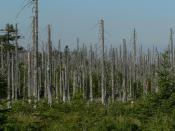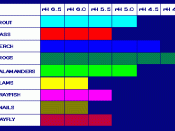Acid Rain and its causes
What is acid rain? Acid rain is rain that is more acidic than normal. Acid rain is a complicated problem. It is not a recent phenomenon. In the 17th century, scientists noted the ill effects that industry and acidic pollution was having on vegetation and people. However, the term acid rain was not coined until two centuries later when Angus Smith published a book called 'Acid Rain' in 1872.
Robert Angus Smith - the scientist who first used the term acid rain - wrote:
"It has often been observed that the stones and bricks of buildings crumble more readily in large towns where much coal is burnt.... I was led to attribute this effect to the slow but constant action of acid rain."
The atmosphere is like an enormous chemist's beaker - a vessel where gases mix, mingle, and react, often turning into poisonous substances capable of returning to earth as rain or snow.
Acid rain is an extremely destructive form of pollution.
Acid rain has been blamed for the "death" of several lakes and rivers in North America and may be responsible for world-wide forest depletion as well.
Each day, thousands of tons of sulfur and nitrogen oxides are pumped into the air by fossil fuel burning plants and automobile exhaust systems. Sunlight converts these gases into sulfuric and nitric acids which then are absorbed by the water particles in clouds. Mixed with rain and snow, they fall back to earth, usually hundreds of miles from the original source of the pollution.
A substance's pH factor, a figure on a scale of 0 - 14, determines a substance's acidity. A pH value of 7 is average. A figure less than 7 indicates higher acidity, and a number more than 7 indicates greater alkalinity. Rainfall with...



Needs Bibliography
Essay is pretty good. Very thorough on what acid rain is and what causes it. However, if you are want to get more info on this article your out of luck there is no bibliography.
0 out of 0 people found this comment useful.